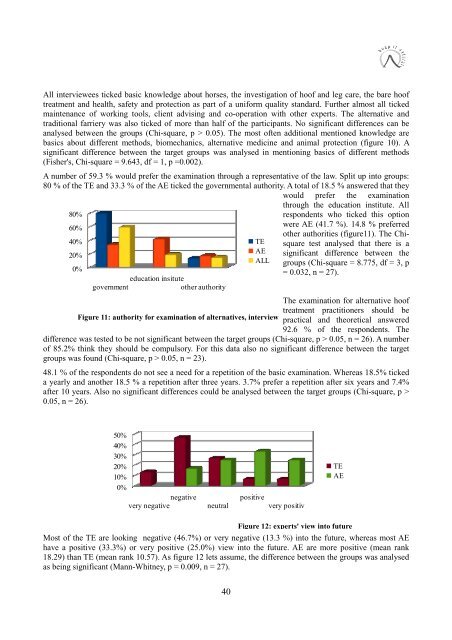Bachelor Thesis - Christina Kuenen - Hufpfleger
Bachelor Thesis - Christina Kuenen - Hufpfleger
Bachelor Thesis - Christina Kuenen - Hufpfleger
Create successful ePaper yourself
Turn your PDF publications into a flip-book with our unique Google optimized e-Paper software.
All interviewees ticked basic knowledge about horses, the investigation of hoof and leg care, the bare hoof<br />
treatment and health, safety and protection as part of a uniform quality standard. Further almost all ticked<br />
maintenance of working tools, client advising and co-operation with other experts. The alternative and<br />
traditional farriery was also ticked of more than half of the participants. No significant differences can be<br />
analysed between the groups (Chi-square, p > 0.05). The most often additional mentioned knowledge are<br />
basics about different methods, biomechanics, alternative medicine and animal protection (figure 10). A<br />
significant difference between the target groups was analysed in mentioning basics of different methods<br />
(Fisher's, Chi-square = 9.643, df = 1, p =0.002).<br />
A number of 59.3 % would prefer the examination through a representative of the law. Split up into groups:<br />
80 % of the TE and 33.3 % of the AE ticked the governmental authority. A total of 18.5 % answered that they<br />
would prefer the examination<br />
80%<br />
60%<br />
40%<br />
20%<br />
0%<br />
education insitute<br />
government<br />
other authority<br />
through the education institute. All<br />
respondents who ticked this option<br />
were AE (41.7 %). 14.8 % preferred<br />
other authorities (figure11). The Chisquare<br />
test analysed that there is a<br />
significant difference between the<br />
groups (Chi-square = 8.775, df = 3, p<br />
= 0.032, n = 27).<br />
The examination for alternative hoof<br />
treatment practitioners should be<br />
Figure 11: authority for examination of alternatives, interview practical and theoretical answered<br />
92.6 % of the respondents. The<br />
difference was tested to be not significant between the target groups (Chi-square, p > 0.05, n = 26). A number<br />
of 85.2% think they should be compulsory. For this data also no significant difference between the target<br />
groups was found (Chi-square, p > 0.05, n = 23).<br />
48.1 % of the respondents do not see a need for a repetition of the basic examination. Whereas 18.5% ticked<br />
a yearly and another 18.5 % a repetition after three years. 3.7% prefer a repetition after six years and 7.4%<br />
after 10 years. Also no significant differences could be analysed between the target groups (Chi-square, p ><br />
0.05, n = 26).<br />
TE<br />
AE<br />
ALL<br />
50%<br />
40%<br />
30%<br />
20%<br />
10%<br />
0%<br />
negative<br />
very negative<br />
neutral<br />
positive<br />
very positiv<br />
TE<br />
AE<br />
Figure 12: experts' view into future<br />
Most of the TE are looking negative (46.7%) or very negative (13.3 %) into the future, whereas most AE<br />
have a positive (33.3%) or very positive (25.0%) view into the future. AE are more positive (mean rank<br />
18.29) than TE (mean rank 10.57). As figure 12 lets assume, the difference between the groups was analysed<br />
as being significant (Mann-Whitney, p = 0.009, n = 27).<br />
40


